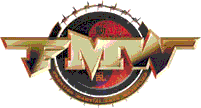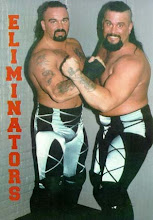
A brief summary of Wrestling in Japan...
Definition
The word puroresu is an abbreviation of "purofesshonaru resuringu," which is simply Japanese for "Professional Wrestling." Thus, puroresu is not a real word and technically should be pronounced "pro res" since the "u" is frequently silent in the Japanese language. Puroresu shouldn't be considered a style, as it only means Professional Wrestling in a different language. The different promotions in Japan have their own styles and use their own terms to describe their style, but the wrestling in Japan is too diverse to clump together. But since the abbreviation is derived from a Japanese word, puroresu for years has been meant as Professional Wrestling in Japan when used by fans around the world. Besides the problem that there is no way to pronounce the word, generally outside of a handful of anal fans the word "puroresu" is used to describe any wrestling promoted by a promotion based in Japan.
Past
Professional Wrestling in Japan first gained popularity in the 1950s, when local hero Rikidozan battled American wrestlers Lou Thesz and The Destroyer to monster TV ratings. After Rikidozan's death in 1963, the popularity of puroresu dipped but soon rose when Rikidozan's students Giant Baba and Antonio Inoki raised to take over their leader's place. Giant Baba was more heavily pushed by JWA (Japanese Wrestling Alliance), and this led to Antonio Inoki becoming unhappy and he tried to take over the company. When that didn't work he split off and formed New Japan, while not soon after Giant Baba also left JWA and formed All Japan. This lead to JWA disbanding. New Japan and All Japan were both very popular in Japan and both Inoki and Giant Baba became nationally recognized stars. The promotions had different styles to help differentiate between them, with Inoki preferring his matches be more realistic and "shoot-style," (he participated in many karate and boxing matches) and Giant Baba having his matches more structured. For more information on Strong Style (New Japan) and King's Road (All Japan), I highly recommend Adam's article on the history of each. You can find his article posted under the Articles section.
While the promotions at first were cordial to each other, by the mid-80s relations were strained as each promotion "stole" stars from the other. Other promotions also began forming, including the UWF (the first shoot-style promotion) and later FMW (the first promotion in Japan to use Death Matches in the main event). This lead to more diversity in Japan, as all four promotions (UWF and its off-shoots, FMW, New Japan, and All Japan) had their own distinct style. Also, from the mid-80s to early 90s many of the greatest wrestlers debuted including Kenta Kobashi, Toshiaki Kawada, Keiji Mutoh, Masahiro Chono, Mitsuharu Misawa, Shinya Hashimoto, and others. These wrestlers helped pave the way for wrestling in the 90s and beyond, as in the mid-90s the popularity of puroresu reached heights that it had not reached in decades. All Japan, All Japan Women, New Japan, FMW, and UWF all were drawing sell-out crowds as high as 65,000 people and at the time there were no signs of it slowing down. Other promotions that formed in the mid-90s included Big Japan Pro Wrestling and Michinoku Pro Wrestling.
Unfortunately, the good times didn't last as the next crop of young stars never fully reached the level of success as the previous generation. New Japan suffered due to the rise of MMA and Inoki wanting his New Japan wrestlers to be seen as just as tough as fighters in Pride and K-1. Unfortunately New Japan wrestlers were embarrassed in a series of MMA matches, leading to the opposite happening. For All Japan, Giant Baba's death in 1999 lead to discord within the promotion, as his presence and booking ability had kept the promotion together. FMW slowly faded and finally died after their star Hayabusa was paralyzed, and the shoot-style promotions lost fans when MMA became more popular. The problems in All Japan lead to Misawa splitting away and taking the vast majority of the roster with him to Pro Wrestling NOAH. Big Japan Pro Wrestling took a major hit after a feud with CZW that saw their attendance dramatically drop. By 2003 the future looked bleak, and even though the main three promotions were surviving none were near the popularity that they had reached only a few years before.
Present
Professional Wrestling in Japan has recovered. While not near the popularity that it obtained in the mid-90s, the major puroresu promotions have finally shown promising signs. After a few generations were skipped in terms of finding a stand-out star, now there are a crop of wrestlers that show serious potential. For the smaller promotions, both Big Japan and Michinoku Pro are still active, with Big Japan recovering and growing new stars. All Japan almost went bankrupt on several occasions, but with a new backer and creative booking the promotion is plugging along. Kohei Suwama, Ryuji Hijikata, and other young stars seem ready to ease the role of established stars Kojima and Mutoh. In New Japan, Antonio Inoki no longer has any power (nor his son-in-law Simon Inoki) and the promotion has strived in his absence. While still not able to fill the Tokyo Dome like it could in its hay day, young stars Nakamura and Tanahashi are finally showing their potential and established stars Nagata and Nakanishi are still popular. Finally, Pro Wrestling NOAH has a number of stars that are growing such as KENTA, Naomichi Marufuji, and Go Shiosaki. Even though the jury is still out on whether they will be able to lead the promotions back to their previous status, after the gloomy predictions from only a few years ago now none of the major promotions seem to be on the brink of disaster.
Definition
The word puroresu is an abbreviation of "purofesshonaru resuringu," which is simply Japanese for "Professional Wrestling." Thus, puroresu is not a real word and technically should be pronounced "pro res" since the "u" is frequently silent in the Japanese language. Puroresu shouldn't be considered a style, as it only means Professional Wrestling in a different language. The different promotions in Japan have their own styles and use their own terms to describe their style, but the wrestling in Japan is too diverse to clump together. But since the abbreviation is derived from a Japanese word, puroresu for years has been meant as Professional Wrestling in Japan when used by fans around the world. Besides the problem that there is no way to pronounce the word, generally outside of a handful of anal fans the word "puroresu" is used to describe any wrestling promoted by a promotion based in Japan.
Past
Professional Wrestling in Japan first gained popularity in the 1950s, when local hero Rikidozan battled American wrestlers Lou Thesz and The Destroyer to monster TV ratings. After Rikidozan's death in 1963, the popularity of puroresu dipped but soon rose when Rikidozan's students Giant Baba and Antonio Inoki raised to take over their leader's place. Giant Baba was more heavily pushed by JWA (Japanese Wrestling Alliance), and this led to Antonio Inoki becoming unhappy and he tried to take over the company. When that didn't work he split off and formed New Japan, while not soon after Giant Baba also left JWA and formed All Japan. This lead to JWA disbanding. New Japan and All Japan were both very popular in Japan and both Inoki and Giant Baba became nationally recognized stars. The promotions had different styles to help differentiate between them, with Inoki preferring his matches be more realistic and "shoot-style," (he participated in many karate and boxing matches) and Giant Baba having his matches more structured. For more information on Strong Style (New Japan) and King's Road (All Japan), I highly recommend Adam's article on the history of each. You can find his article posted under the Articles section.
While the promotions at first were cordial to each other, by the mid-80s relations were strained as each promotion "stole" stars from the other. Other promotions also began forming, including the UWF (the first shoot-style promotion) and later FMW (the first promotion in Japan to use Death Matches in the main event). This lead to more diversity in Japan, as all four promotions (UWF and its off-shoots, FMW, New Japan, and All Japan) had their own distinct style. Also, from the mid-80s to early 90s many of the greatest wrestlers debuted including Kenta Kobashi, Toshiaki Kawada, Keiji Mutoh, Masahiro Chono, Mitsuharu Misawa, Shinya Hashimoto, and others. These wrestlers helped pave the way for wrestling in the 90s and beyond, as in the mid-90s the popularity of puroresu reached heights that it had not reached in decades. All Japan, All Japan Women, New Japan, FMW, and UWF all were drawing sell-out crowds as high as 65,000 people and at the time there were no signs of it slowing down. Other promotions that formed in the mid-90s included Big Japan Pro Wrestling and Michinoku Pro Wrestling.
Unfortunately, the good times didn't last as the next crop of young stars never fully reached the level of success as the previous generation. New Japan suffered due to the rise of MMA and Inoki wanting his New Japan wrestlers to be seen as just as tough as fighters in Pride and K-1. Unfortunately New Japan wrestlers were embarrassed in a series of MMA matches, leading to the opposite happening. For All Japan, Giant Baba's death in 1999 lead to discord within the promotion, as his presence and booking ability had kept the promotion together. FMW slowly faded and finally died after their star Hayabusa was paralyzed, and the shoot-style promotions lost fans when MMA became more popular. The problems in All Japan lead to Misawa splitting away and taking the vast majority of the roster with him to Pro Wrestling NOAH. Big Japan Pro Wrestling took a major hit after a feud with CZW that saw their attendance dramatically drop. By 2003 the future looked bleak, and even though the main three promotions were surviving none were near the popularity that they had reached only a few years before.
Present
Professional Wrestling in Japan has recovered. While not near the popularity that it obtained in the mid-90s, the major puroresu promotions have finally shown promising signs. After a few generations were skipped in terms of finding a stand-out star, now there are a crop of wrestlers that show serious potential. For the smaller promotions, both Big Japan and Michinoku Pro are still active, with Big Japan recovering and growing new stars. All Japan almost went bankrupt on several occasions, but with a new backer and creative booking the promotion is plugging along. Kohei Suwama, Ryuji Hijikata, and other young stars seem ready to ease the role of established stars Kojima and Mutoh. In New Japan, Antonio Inoki no longer has any power (nor his son-in-law Simon Inoki) and the promotion has strived in his absence. While still not able to fill the Tokyo Dome like it could in its hay day, young stars Nakamura and Tanahashi are finally showing their potential and established stars Nagata and Nakanishi are still popular. Finally, Pro Wrestling NOAH has a number of stars that are growing such as KENTA, Naomichi Marufuji, and Go Shiosaki. Even though the jury is still out on whether they will be able to lead the promotions back to their previous status, after the gloomy predictions from only a few years ago now none of the major promotions seem to be on the brink of disaster.














































No comments:
Post a Comment